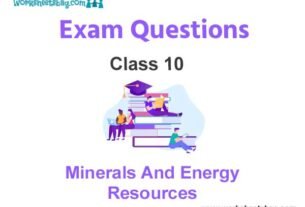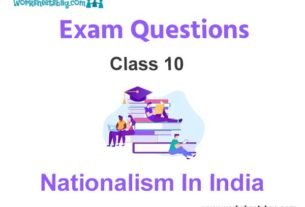Please see Chapter 10 Light Reflection and Refraction Exam Questions Class 10 Science below. These important questions with solutions have been prepared based on the latest examination guidelines and syllabus issued by CBSE, NCERT, and KVS. We have provided Class 10 Science Questions and answers for all chapters in your NCERT Book for Class 10 Science. These solved problems for Light Reflection and Refraction in Class 10 Science will help you to score more marks in upcoming examinations.
Exam Questions Chapter 10 Light Reflection and Refraction Class 10 Science
ONE MARK QUESTIONS
Question: Define the following terms in relation to concave spherical mirror:
a. Pole
b. Centre of curvature
c. Radius of curvature
d. Principal axis
e. Principal focus
f. Aperture
g. Focal length (each one mark)
Answer: a. The mid point of mirror is known as pole.
b. The centre of curvature of a spherical mirror is the centre of that sphere of which mirror is a part,
c. The distance between pole and centre of curvature is called radius of curvature of the mirror.
d. The straight line joining the pole and centre of curvature is called principal axis.
e. The point on the principal axis through which parallel rays to the principal axis passes or appear to pass after reflection.
f. The diameter of the mirror or size of the mirror is called aperture.
g. The distance between focus and pole of a mirror is the focal length of the mirror.
Question: Write down four important characteristics of image formed by a plane mirror.
Answer: Image is virtual, erect, laterally inverted and of same size as object.
Question: Describe a spherical mirror.
Answer: Spherical mirror is a part of a sphere. If reflection takes place from inside, it is said to be concave mirror, and if the reflection takes place from outside surface it is a convex mirror.

Question: Give two uses of a convex lens.
Answer: Convex lens are used in
(i) spectacles,
(ii) telescopes,
(iii) microscopes,
(iv) camera.
Question: What is a prism?
Answer: A prism is an optical device with two triangular bases along with three rectangular lateral surfaces commonly inclined at an angle of 60°.
TWO MARKS QUESTIONS

Question: Draw a ray diagram for the image formed by a concave mirror when the object is placed beyond its centre of curvature.
Answer:

Question: With the help of ray diagram show that angle of incidence is equal to the angle of reflection when a ray is incident on the concave/convex mirror.
Answer:

Question: A doctor has prescribed a corrective lens of power +1.5 D. Find the focal length of the lens. Is the prescribed lens diverging or converging?
Answer:
f = 1/P1 m=1/ 1.5 m = + 10/15 m =+2/3m
f =+ 66.7 cm
+f means the lens is convex (converging) lens.
Question: With the help of a ray diagram, show that the formation of the image of an object by a concave mirror when it is placed at the centre of curvature.
Answer:

Question: Refractive index of turpentine oil, kerosene and alcohol are 1.47, 1.44 and 1.36 respectively. On the basis of this information, complete the following ray diagram to show path of ray of light through each medium.
Give reason for your answer.

Answer: When a ray passes from optically rarer to denser medium it bends towards the normal.

Question: Differentiate between reflection and refraction of light.
Answer:

Question: An object is placed at the focus of a convex lens. Draw a ray diagram to locate the position of the image formed, if any. State its position and nature.
Answer: Image is formed at 3, image will be real, inverted and enlarged.

Question: Define the term magnification. Write its formula also.
Answer: Magnification m of a mirror gives the relative extent to which the size of image of an object is magnified w.r.t. size of object. It is the ratio of size of image (h2) to size of an object (h1).
m = Size of image/Size of object =h2/h1=-v/u
Question: With the help of ray diagrams differentiate between aconverging lens and a diverging lens.
Answer:

Question: If the image formed by a spherical mirror for all positions of the object placed in front of it, is always erected and diminished, what type of mirror is it? Draw a labelled ray diagram to support your answer.
Answer: It is a convex mirror. Ray diagram for any position of object

Question: Write the relation between object distance and image distance from a lens and focal length of a lens.
Answer: 1/f=1/v-1/u
THREE MARKS QUESTIONS
Question. State the types of mirrors used for (i) headlights and (ii) rear view mirrors, in motorcycles. Give reason to justify your answer in each case.
Answer: (i) Concave mirrors are used in headlights of cars to get powerful beams of light.
(ii) Convex mirrors are used as rear-view mirrors of vehicle to get a wider field of view and and erect image of traffc behind.
Question. An object is placed between infinity and the pole of a convex mirror. Draw a ray diagram and also state the position, the relative size and the nature of the image formed.
Answer:
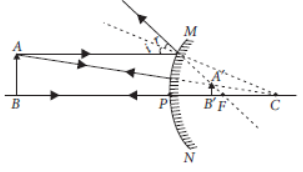
Position : Image is formed between pole and
principal focus of the mirror.
Relative size : Image formed is diminished.
Nature : Image formed is virtual and erect.
Question. With the help of a ray diagram explain why a convex mirror is preferred for rear view mirrors in the motor cars.
Answer: Convex mirror is preferred for rear view mirrors in motor cars because no matter where the object is located infront of convex mirror, it always gives erect and diminished image of the object, so that driver is able to see the large traffic view in small area and the image is erect.
This can be interpreted from the following diagram.

Question. Copy this figure in your answer-book and show the direction of the light ray after reflection.

Answer:

The incident ray passing through focus, goes parallel to the principal axis after the reflection through the given mirror.
Question. What is meant by power of a lens? What does its sign (+ve or –ve) indicate? State its S.I. unit related to focal length of a lens?
Answer: Positive sign (+) of power indicates that lens is convex and negative sign (–) of power indicates that lens is concave.
If focal length (f) is expressed in metres, then, power is expressed in dioptres. The SI unit of power is dioptre. Thus, 1 dioptre is the power of lens whose focal length is 1 metre. 1 D = 1m–1
Question. The refractive indices of glass and water with respect to air are 3/2 and 4/3 respectively. If speed of light in glass is 2 × 108 m/s, find the speed of light in water.
Answer: Given : ang = 3/2 , anw = 4/3
Speed of light in glass, v = 2 × 108 m/s
We know, ang = speed of lightin air/speed of light inmedium

Question. (a) To construct a ray diagram we use two rays which are so chosen that it is easy to know their directions after reflection from the mirror. Use these two rays and draw ray diagram to locate the image of an object placed between pole and focus of a concave mirror.
(b) A concave mirror produces three times magnified image on a screen. If the objects placed 20 cm in front of the mirror, how far is the screen from the object?
Answer: (a) Two lights rays whose path of reflection are priorly known are :
(i) When the incident ray passes through the centre of curvature of a concave mirror, it gets reflected in the same path.
(ii) When the ray is incident obliquely to the principal axis, towards the pole of mirror, it gets reflected back by making equal angles with the principal axis (laws of reflections).
Suppose an object is placed between focus and pole of the concave mirror. Then by using the above two rays, the image of the object can be located as
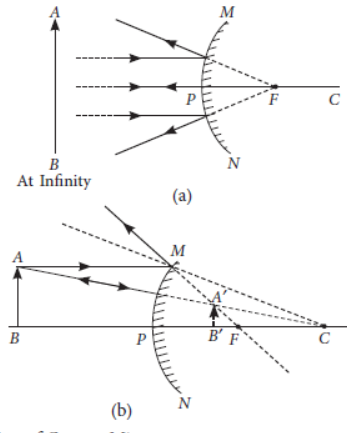
Image formed is virtual, erect, magni ed and it is formed behind the mirror.
(b) Given : Magnification, m = – 3
Object-distance, u = – 20 cm
Magnification, m = -v/u or -3 = -v/-20
or v = – 60 cm
The screen is placed in front of the mirror at a distance of 60 cm from the pole.
Thus, the screen is placed (= 60 cm – 20 cm) 40 cm away from the object.
Question. A spherical mirror produces an image of magnification –1 on a screen placed at a distance of 50 cm from the mirror.
(a) Write the type of mirror.
(b) Find the distance of the image from the object.
(c) What is the focal length of the mirror?
Answer: (a) Concave mirror
(b) Magnification, m = -v/u or −1= -v/(-50)
∴ Distance of the image from the object is,
v = – 50 cm
(c) As the image is formed at centre of curvature i.e., v = R.
∴ focal length of the mirror, f = -50/2= -25cm
Question. If the image formed by mirror for all positions of the object placed in front of it is always virtual and diminished, state the type of the mirror. Draw a ray diagram in support of your answer. Where are such mirrors commonly used and why?
Answer: If the image formed is always virtual and diminished then the mirror used is convex.
state the path of these rays after reflection from a concave mirror. Use these two rays to find the nature and position of the image of an object placed at a distance of 15 cm from a concave mirror of focal length 10 cm.

Convex mirrors are widely used as rear view mirrors in cars, motorcycles etc. It produces an erect image that is smaller in size than the object hence giving a wide view.
Question. Suppose you have three concave mirrors A, B and C of focal lengths 10 cm, 15 cm and 20 cm. For each concave mirror you perform the experiment of image formation for three values of object distances of 10 cm, 20 cm and 30 cm. By giving reason, answer the following:
(a) For the three object distances, identify the mirror/mirrors which will form an image of magnification –1.
(b) Out of the three mirrors, identify the mirror which would be preferred to be used for shaving purposes/make up.
(c) For the mirror B draw ray diagram for image formation for object distances 10 cm and 20 cm.
Answer: Given : fa = 10 cm, fb = 15 cm, fc = 20 cm ua = 10 cm, ub = 20 cm, uc = 30 cm
(a) Magnification of –1 implies that size of image is same as that of object or image is formed at the same distance as of the object. This is the case when the object distance, u = 2f, i.e., when the object is at the centre of the curvature.
For fa , ub and for fb, uc , we get magnification – 1.
(b) Concave mirror forms virtual, erect and magnified image when the object is between focus and pole of the mirror, i.e., direct distance should be less than the focal length of the mirror.
For object distance 10 cm, mirrors of focal length fb = 15 cm and fc = 20 cm can be used.
(c)
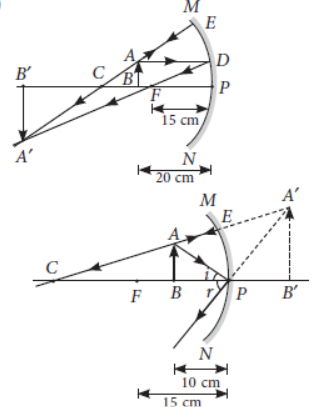
Question. A student has focused the image of a candle flame on a white screen using a concave mirror. The situation is a given below :
Length of the flame = 1.5 cm
Focal length of the mirror = 12 cm
Distance of flame from the mirror = 18 cm
If the flame is perpendicular to the principal axis of the mirror, then calculate the following:
(a) Distance of the image from the mirror
(b) Length of the image
If the distance between the mirror and the flame is reduced to 10 cm, then what would be observed on the screen? Draw ray diagram to justify your answer from this situation.
Answer: Given: focal length of the concave mirror,
f = – 12 cm
Length of the flame, h = 1.5 cm
Distance of flame from the mirror, u = –18 cm
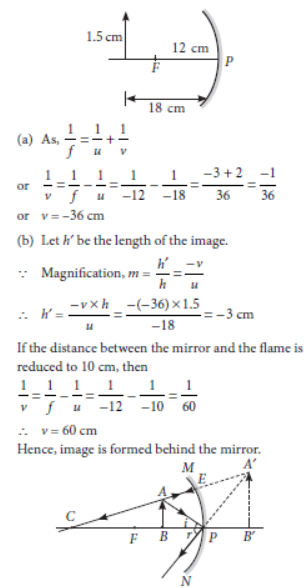
Question. A student wants to project the image of a candle flame on the walls of school laboratory by using a mirror.
(a) Which type of mirror should he use and why?
(b) At what distance in terms of focal length ‘f ’ of the mirror should he place the candle flame so as to get the magnified image on the wall?
(c) Draw a ray diagram to show the formation of image in this case.
(d) Can he use this mirror to project a diminished image of the candle flame on the same wall? State ‘how’ if your answer is ‘yes’ and ‘why not’ if your answer is ‘no’
Answer: (a) He should use concave mirror to get image of candle flame on the walls of school laboratory.
Because concave mirror is a converging mirror and produce real image.
(b) He should place the candle flame in between centre of curvature C and principal focus F of the mirror to get the magnified image on the wall.

(d) Yes, he can use concave mirror to project a diminished image of the candle flame on the same wall. He has to place the candle flame beyond centre of curvature to get diminished image.
Question. To construct a ray diagram we use two rays of light which are so chosen that it is easy to determine their directions after reflection from the mirror.
Answer: We use two rays of light, one passing through the centre of curvature of a concave mirror, and another is parallel to the principal axis. After reflection, the ray passing through the centre of a concave mirror is reflected back along the same path and the ray parallel to the principal axis will pass through the principal focus.
u = –15 cm, f = –10 cm

From ray diagram, v = –30 cm, i.e., beyond C Nature of image is real, inverted and magnified.
Question. It is desired to obtain an erect image of an object, using concave mirror of focal length of 12 cm.
(i) What should be the range of distance of a object placed in front of the mirror?
(ii) Will the image be smaller or larger than the object. Draw ray diagram to show the formation of image in this case.
(iii) Where will the image of this object be, if it is placed 24 cm in front of the mirror?
Draw ray diagram for this situation also to justify your answer.
Show the positions of pole, principal focus and the centre of curvature in the above ray diagrams.
Answer: Given : focal length of the concave mirror
f = 12 cm
(i) If the object is placed between the pole and focus of the concave mirror, then the image formed is virtual and erect. Therefore, the range of distance of the object should be 0 < u < 12 cm.
(ii) The image formed will be enlarged as shown below.

(iii) If the object is placed 24 cm in front of the mirror i.e., at the centre of the curvature then the image will also be formed at the centre of the curvature.
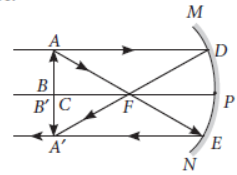
Question. How should a ray of light be incident on a rectangular glass slab so that it comes out from the opposite side of the slab without being displaced?
Answer: A ray of light should be incident perpendicular to the surface of the rectangular glass slab so that it comes out from the opposite side of the slab without being displaced.
Question. A spherical mirror produces an image of magnification –1 on a screen placed at a distance of 40 cm from the mirror.
(i) Write type of mirror.
(ii) What is the nature of the image formed?
(iii) How far is the object located from the mirror?
Answer: (i) This is a concave mirror.
(ii) The image is real and inverted and of same size.
(iii) As m = – 1
∴ m = -v/u ⇒ −1 = -v/u ⇒ u = v
Hence, object is located at centre of curvature i.e., at distance of 40 cm from the pole of the mirror.
Question. (a) Define the following terms in the context of spherical mirrors:
(i) Pole
(ii) Centre of curvature
(iii) Principal axis
(iv) Principal focus
(b) Draw ray diagrams to show the principal focus of a
(i) Concave mirror
(ii) Convex mirror
(c) Consider the following diagram in which M is a mirror and P is an object and Q is its magnified image formed by the mirror.

State the type of the mirror M and one characteristic property of the image Q.
Answer: (a) (i) Pole : The centre of the reflecting surface of a spherical mirror is a point called the pole. It lies in the surface of the mirror and its represented by the letter P.
(ii) Centre of curvature : The reflecting surface of a spherical mirror is a part of a sphere which has a
centre. Tnis point is called the centre of curvature of spherical mirror and is represented by the letter C.
(iii) Principal axis : An imaginary line passing through the pole and the centre of curvature of a spherical mirror and normal to the mirror at its pole is called principal axis.
(iv) Principal focus : Incident rays parallel to principal axis, after reflection either converge to as appear to diverge from a fixed point on the principal axis known as principal focus of the spherical mirror.
(b) (i)

(c) The object is placed between focus and pole of the mirror and a magnified image is formed behind the mirror.
∴The mirror is concave and image formed is virtual and erect.
Question. A girl was playing with a thin beam of light from her laser torch by directing it from different directions on a convex lens held vertically. She was surprised to see that in a particular direction the beam of light continues to move along the same direction after passing through the lens. State the reason for this observation.
Answer: The girl playing with a thin beam of light from her laser torch must incident the laser beam of light through optical centre of the convex lens.
A ray of light though the optical centre of a lens passes without suffering any deviation.
Question. Draw a ray diagram to determine the position of image formed of an object placed between the pole and the focus of a concave mirror.
Answer: Image formed by an object when it is kept between the pole and the focus of a concave mirror is

Question. The absolute refractive indices of glass and water are 4/3 and 3/2 respectively. If the speed of light in glass is 2 × 108 m/s, calculate the speed of light in (i) vacuum, (ii) water.
Answer: Given that : ng = 4/3 , nw = 3/2 , vg 2x 108 m/s
Absolute refractive index of a medium, nm = c/v
where, c is the speed of light in vacuum and v is the speed of light in medium.

Note : The values given in question are not correct as the speed of light in vacuum is 3 × 108 m/s
Question. The image formed by a spherical mirror is real, inverted and its magnification is –2. If the image is at a distance of 30 cm from the mirror, where is the object placed?
Find the focal length of the mirror. List two characteristics of the image formed if the object is moved 10 cm towards the mirror.
Answer: Since the image formed is real and inverted, the mirror is concave.
Magnification,m = -v/u ⇒ -2 = -v/u ⇒ v = 2u
Now, if v = – 30 cm then u = – 15 cm
As focal length of the mirror is
f = uv/u + v = -15 x -30/-15 x -30 = f =450/-45 = -10cm
If the object is shified 10 cm the mirror, then the object is between principal focus and the optical centre and the image formed will be virtual and erect.
Question. A ray of light is incident on a convex mirror as shown. Redraw the diagram and complete the path of this ray after reflection from the mirror. Mark angle of incidence and angle of reflection on it.

Answer:
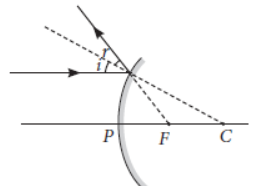
Question. “A ray of light incident on a rectangular glass slab immersed in any medium emerges parallel to itself.” Draw labelled ray diagram to justify the statement”.
Answer:
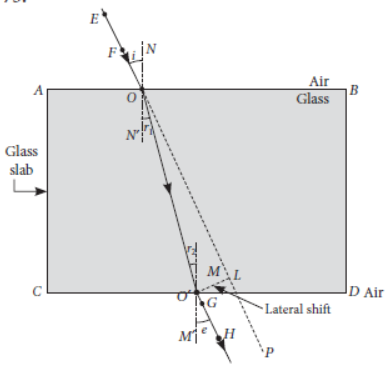
Question. The refractive index of water is 1.33 and the speed of light in air is 3 × 108 m s–1. Calculate the speed of light in water.
Answer: Refractive index of water, nw = 1.33
Speed of light in air, c = 3 × 108 m/s
As we know that refractive index of medium,
nm = speed of light in air/speed of light in medium = c/vm
Here, our medium is water.
So, nw = c/vw
where, vw is the speed of light in water.
∴ 1. 33 = 3 x 108/vw , m/s
∴ 1. 33 = 3 x 108/vw = 2.25 x 108 m/s
∴ Speed of light in water is 2.25 × 108 m/s.
Question. Explain with the help of a diagram, why a pencil partly immersed in water appears to be bent at the water surface.
Answer: This phenomenon is due to refraction of light at the interface of two media. Light rays coming from the immersed end C of the pencil bend away from the normal at the interface on reaching there as the rays are travelling from optically denser to a rarer medium. As shown in the diagram, when viewed from above, they appear to come from the point C’, slightly raised. This way, all the rays from the immersed portion of the pencil bend and as a result it appears to be raised. Hence the pencil appears to be bend at the interface.

Question. Draw ray diagram to represent the nature, position and relative size of the image formed by a convex lens for the object placed
(a) at 2F1
(b) between F1 and optical centre O of lens
Answer: (a) Ray diagrams of an object placed at 2F1 infront of convex lens can be drawn as follows:

(i) Thus image formed is real and inverted.
(ii) Image is formed at 2F2.
(iii) Image formed is of same size as that of the object.
(b) Ray diagrams of an object placed between F1 and optical centre O of lens can be drawn as follows:
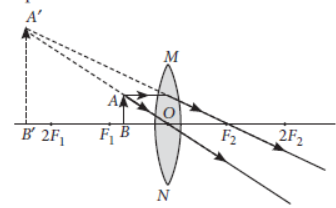
(i) The image formed is virtual and erect.
(ii) Image is formed infront of the lens.
(iii) Image formed is enlarged.
Question. Draw the given diagram in your answer book and complete it for the path of ray of light beyond the lens.

Answer:
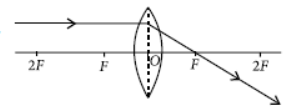
An incident light coming parallel to the principal axis after refraction through convex lens passes through focus.
Question:26. In a household electric circuit, different appliances are connected in parallel to one another. Give two reasons An electrician puts a fuse of rating 5A in that part of domestic electrical circuit in which an electrical heater of rating 1.5 kW, 220V is operating. What is likely to happen in this case and why? What change, if any, needs to be made?
Answer: The two reasons for connecting the appliances in parallel are as follows.
1. Each appliance will be at same potential (voltage).
2. If one of the appliances fails the other will still keep working.
Given
Voltage = 220V;
Power = 1.5kW = 1500W
(1kW = 1000W)
Now
P = VI
⇒l=p/v=1500/200=6.8
Question: State the laws of refraction.
Answer: Snell’s laws of refraction
a. Incident ray, refracted ray and normal to the point of incidence lie in the same plane.
b. sini/sinr=1/2n
Question: (a) For the same angle of incidence 45°, the angle of refraction in two transparent media; I and II is
20° and 30° respectively. Out of I and II, which medium is optically denser and why?
(b) Light enters from air to diamond which has refractive index of 2.42. Calculate the speed of light in diamond, if speed of light in air is
3#108 ms-1.
Answer: a. For the same angle of incidence. The refracted ray in medium I deviates less than in medium II. Hence medium I is more denser than medium II.

b. Refractive index of diamond = 2.42 Speed of light in air = 3#108 m/s Speed of light in diamond = ?
n= Speed of light in air/ Speed of light in diamond=c/v
v =c/n=3×108/2.42
v=1.24×108m/s
Question: A student focused the image of a candle flame on a white screen by placing the flame at various distances from a convex lens. He noted his observations:

a. From the above table, find the focal length of lens without using lens formula.
b. Which set of observations is incorrect and why?
c. In which case the size of object and image will be
same? Give reason for your answer.
Answer: a. In observation (iii) of the table given u = 30 cm, v = 30 cm, which is only possible when u = v = 2f(at C)
2f = 30 or f=15 cm
Question: (a) Define power of a lens and write its SI unit. (b) A convex lens forms a real and inverted image of a needle at a distance of 50 cm from it. Where is the needle placed in front of the lens, if image size is equal to the object size? Also, find the power of the lens.
Answer: a. Power of a lens is the ability of a lens to bend a ray of light incident upon it. It is equal to the reciprocal of the focal length of the lens.
Question: (a) Water has refractive index 1.33 and alcohol has refractive index 1.36. Which of the two medium is optically denser? Give reason for your answer. Draw a ray diagram to show the path of a ray of light passing obliquely from water to alcohol.
(b) The absolute refractive index of diamond is 2.42 and the absolute refractive index of glass is 1.50. Find the refractive index of diamond with respect to glass.
Answer: a. More refractive index means more optical denser medium. Here refractive index of water is 1.33 and of alcohol is 1.36 nAl > nw .
Hence alcohol is more optical denser than water.

Question: (a) State Snell’s law of refraction.
(b) When a ray of light travelling in air enters obliquely into a glass slab, it is observed that the light ray emerges parallel to the incident ray but it is shifted sideways slightly. Draw a ray diagram to illustrate it.
Answer: (a) Snell’s law sini/sinr=constant
(Refractive index of the medium)
(b)

Question: A student wants to project the image of a candle flame on a screen 60 cm in front of a mirror by keeping the flame at a distance of 15 cm from its pole.
a. Write the type of mirror he should use.
b. Find the linear magnification of the image produced.
c. What is the distance between the object and its image?
d. Draw a ray diagram to show the image formation in this case.
Answer: Given: v =- 60 cm
u =- 15 cm
a. Since the image is real the minor is concave
b. m =v/u=-(-60)/(-15)=-4
m=-4
c. Distance between object position and image position = 60 – 15 = 45 cm.

Question: A 4.5 cm needle is placed 12 cm away from a convex mirror of focal length 15 cm. Give the location of image and magnification. Describe what happens to the image as the needle is moved farther from the mirror.
Answer:

Size of image is smaller than size of object.
Question: Discuss the position and nature of the image formed by a concave mirror when the object is moved from infinity towards the pole of the mirror.
Answer: When an object is moved from 3 toward the pole of a concave mirror then its image moves from focus to infinity.
Question: If the image formed by a mirror for all positions of the object placed in front of it is always erect and diminished, what type of mirror is it? Draw a ray diagram to justify your answer. Where and why do we generally use this type of mirror?
Answer: Only in convex mirror, for all positions of the object placed in front of it is always virtual, erected and diminished. Hence this mirror is convex mirror.

Convex mirrors are used in automobiles as a rear view mirror because of wider field of view and formation of erect image.
Question: A ray of light is incident obliquely on a glass slab. Draw a ray diagram showing the path of the light ray.
Clearly, mark angle of incidence, angle of refraction, angle of emergence and lateral displacement of the ray. Give a formula to find refractive index of glass slab in terms of angle of incidence and angle of refraction.
Answer: When a ray passes from optical rarer to denser medium, it bends towards the normal and vice versa.
∠i = angle of incidence
∠r = angle of refraction
∠e = angle of emergence
d = lateral displacement.
agn=sinli/
Question: (a) A ray of light falls normally on a face of a glass slab. What are the values of angle of incidence and angle of refraction of this ray?
(b) Light enters from air to a medium X. Its speed in medium X becomes 1.5×108 ms-1. Find the refractive index of medium X.
Answer: a. When a ray of light falls normally on a glass slab then i = 0, and r = 0
b. vm= 1.5 108 m/s
c = 3×108 m/s
We know Refractive index
n=c/vm
or n=3×108/1.5×108=2
n=2
FIVE MARKS QUESTIONS
Question: (a) Define real image of an object.
(b) Name the mirror that:
– can give real as well as virtual image of an object.
– will always give virtual image of same size of an object.
– will always give virtual and diminished image of an object.
– is used by a doctor in examining teeth,
(b) With the help of a ray diagram explain the use of concave mirror as solar concentrators.
Answer: a. When the reflected rays after reflection actually meet at a point then real image is formed.
b. Concave mirror
Plane mirror
Convex mirror
Concave mirror
c. The rays coming from the sun are parallel to principal axis and will concentrate at focus after reflection.

Question: An object of height 4.0 cm is placed at a distance of 30 cm from the optical centre ‘O’ of a convex lens of focal length 20 cm. Draw a ray diagram to find the position and size of the image formed. Mark optical centre ‘O’ and principal focus ‘F’ on the diagram. Also find the approximate ratio of size of the image to the size of the object.
Answer: Ray diagram: Position of O and F


Question: Name the type of mirror used in the following:
a. Solar furnace
b. Side/rear – view mirror of a vehicle.
Draw a labelled ray diagram to show the formation of image in each of the above two cases.
Which of these mirrors could also form a magnified and virtual image of an object? Illustrate with the help of a ray diagram.
Answer: a. Concave mirror

b. Convex mirror

Concave mirror form magnified virtual image of an object.

Question: (a) Define principal focus of a spherical mirror.
(b) For what position of the object does a concave mirror form a real, inverted and diminished image of the object? Draw the ray diagram.
(c) An object 4 cm high is placed at a distance of 6 cm in front of a concave mirror of focal length 12 cm. Find the position of the image formed.
Answer: a. The point on the principal axis at which the light rays parallel to principal axis after reflection from
a concave mirror actually meet or appear to come from in convex mirror on the principal axis is called principal focus.
b. In case of a concave mirror, when the object is placed beyond 2F(C) then image formed is real, inverted and diminished.

f=-12
u=-6 cm
v=?
1/f=1/u+1/v
1/v=-1/12+1/6=-1+2/12=1/12
v=12cm
Question: (a) A thin converging lens forms a
– Real magnified image.
– Virtual magnified image of an object placed in front of it.
Write the positions of the objects in each case.
(b) Draw labelled ray diagrams to show the image formation in each case.
(c) How will the following be affected on cutting this lens into two halves along the principal axis?
– Focal length
– Intensity of the image formed by half lens.
Answer: a. When object is placed in between F and 2F(C) of a converging lens it will form a real magnified image.

When object is placed in between F1 and optical centre O of a converging lens, it will form a virtual magnified image of the object.

c. When lens is cut along the principal axis its focal length remains same but intensity is reduced.
Question: (a) Under what condition, a concave mirror produces a virtual and magnified image? Draw a labelled ray diagram to show the formation of image in the above case. Also, state the position of object to produce magnified and real image.
(b) A ray of light moving along principal axis is falling on a concave mirror. Draw the path of reflected ray. Also, state the values of angle of incidence and reflection in this case.
Answer: a. A concave mirror will produce a virtual and magnified image of the object if placed in between F and pole of the mirror.

Real and magnified image will be formed if the object is placed in between 2F(C) and F in front of a concave mirror.
b. Ray of light moving along the principal axis will retraces it path because incident angle ∠ +i = reflected angle ∠+r = 0.

Question: (a) Define optical centre of a spherical lens.
(b) You are given a convex lens of focal length 30 cm. Where would you place an object to get a real, inverted and highly enlarged image of the object?
Draw a ray diagram showing the image formation,
(c) A concave lens has a focal length of 20 cm. At what distance an object should be placed so that it forms an image at 15 cm away from the lens?
Answer: a. Mid point of a lens through which a ray of light passes undeviated.
b. At f =+ 30 cm, because when object is kept at fin case of a convex lens then its real, inverted and highly enlarged image is formed

c. f =- 20 cm, v =- 15 cm, u = ?
Lens formula

Question: (a) Describe an activity to find the approximate value of focal length of a concave mirror.
(b) What happens to the size of the image of an object when it is moved gradually away from a concave mirror?
(c) In an experiment to study refraction through a glass slab, it is observed that a ray of light undergoing refraction emerges parallel to the direction of incident ray. Why does it happen so?
Explain with the help of a diagram.
Answer: a. By holding concave mirror, focus the reflected light incident on the mirror on a sheet of paper.
The distance between paper sheet and mirror will give the approximate value of focal length of concave mirror.
b. Size of image reduces

c. The opposite faces of rectangular glass slab AB and DC are parallel and extent of bending on opposite faces is equal and opposite∠i = ∠e .
Hence incident ray is parallel to emergent ray.
Question: Which lens can be used as a magnifying glass? For which position of object does a convex lens form:
a. a virtual and erect image?
b. a real and inverted image of same size as that of
object? Draw labelled ray diagrams to show the
formation of the required image in each of the above two cases.
Answer: A convex lens of shorter focal length is used as a magnifying lens (glass).
a. A virtual and erect image in a convex lens is formed when object is placed in between F and O.

b. A real and inverted image of same size as that of an object is formed by a convex lens when the object is placed at 2F(C)

Question: (a) Write one use of concave mirror as well as convex mirror.
(b) Draw ray diagrams for the following cases when a ray of light:
(i) passing through centre of curvature of a concave mirror is incident on it.
(ii) parallel to principal axis is incident on convex minor.
(iii) is incident at the pole of a convex mirror.
(iv) passing through focus of a concave mirror incident on it.
Answer: a. Use of concave mirrors
(i) Head light of vehicles
(ii) Used by ENT doctors to focus the light
Use of convex mirror: Used as rear view mirrors in vehicles.


Question: (a) The refractive index of diamond is 2.42. What is the meaning of this statement?
(b) Redraw the diagram given below in your answer book and complete the path of ray.

(c) What is the difference between virtual images produced by concave, plane and convex mirrors?
(d) What does the negative sign in the value of magnification produced by a mirror indicates about a image?
Answer: a. The refractive index of diamond is 2.42 means that speed of light in diamond is (1/2.42) times the speed of light in air.


d. negative magnification produced by a mirror mean image is real.

